The 100th anniversary of the First World War is now finished but the records will continue to be preserved at the Archives and accessible to current and future generations who want to know more about the time period. In addition, this blog will remain on our website as an additional resource.
December 2018 Posts:
- 31 December: At Home and Away: the end of our First World War blog
- 21 December: Canadian Light Horse Christmas dinner
- 17 December: “Such an employment would be not only unseemly, but abhorrent”: Controversy and the Winnipeg Cenotaph
- 10 December: HBC and the re-instatement of discharged service men into the workforce
- 3 December: The Spanish Influenza, a visit from the U. S. President and a party with the Queen: Col. R. M. Dennistoun’s report from London
31 December 2018
At Home and Away: the end of our First World War blog
For the past four and a half years, the Archives has been blogging weekly about records in our holdings from the time of the First World War, documenting activities both at home and overseas. During this time, the Archives has made it a priority to process and describe all of our First World War era records, particularly those related to the experience of Manitobans who served overseas. Search “First World War” in Keystone to find these records.
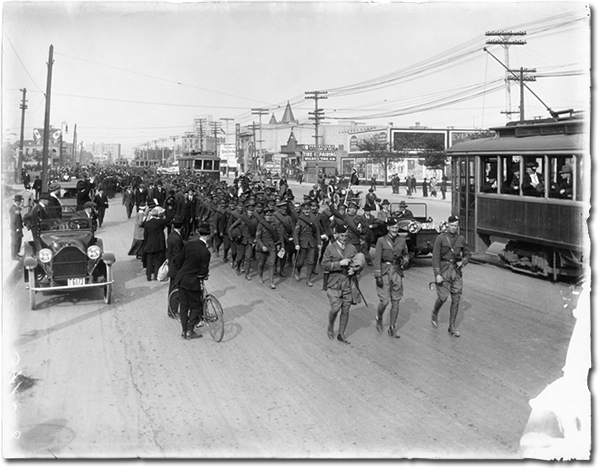
We have learned a great deal about Manitobans who served overseas, activities on the home front, and activities of the Manitoba government during wartime, including the construction of the Manitoba Legislative Building and the granting of the vote to women.
In this time, we have mounted displays and held public events to increase awareness of the Archives’ holdings and to engage Manitobans with this era of Manitoba history:
- At Home: Winnipeg, 1914-1915 – a display of photographs taken by L.B. Foote
- “On Active Service”: First World War letters at the Archives of Manitoba
- The First World War in Letters – a public reading event, 10 November 2018
- An open house to commemorate the 100th anniversary of Women’s Suffrage in Manitoba, held 9 January 2016
- The Panoramic Record: Wide-Angle Photographs from the time of the First World War
- An open house to commemorate the 100th anniversary of the Battle of Vimy Ridge, held 12 April 2017
- 1918: the last year of the war – a display of records documenting 1918, including letters and diaries created by Manitobans who were serving overseas
- Reading event and open house to commemorate the 100th anniversary of the end of the First World War, held 8-10 November 2018
The 100th anniversary of the First World War is now finished but the records will continue to be preserved at the Archives and accessible to current and future generations who want to know more about the time period. In addition, this blog will remain on our website as an additional resource.
Feedback
E-mail us at archiveswebmaster@gov.mb.ca with a comment about this blog post. Your comments may be included on this page.
21 December 2018
Canadian Light Horse Christmas dinner
After the Armistice, George Hambley, cavalryman with the Canadian Light Horse, was part of the march to Germany to assume occupation duties. On 23 December 1918, Hambley and his squadron reached Godesberg, Germany.
On Christmas Day 1918, the Canadian Light Horse had dinner at the Rhine Hotel near Godesberg. Hambley wrote about it the next day, 26 December 1918, in his diary. He was very impressed with the hotel and the scenery:
“The Hotel is a royal place situated on the banks of the river. The scene from here of the Rhine is surpassingly beautiful – The foreground of the river flowing turbid swift and strong to the sea stretches away some half mile to the farther side which is the centre of the picture – Here nestle a series of rich dwelling houses, hotels, and summer resorts of the richest class.”
Hambley drew the menu in his diary. The menu consisted of tomato soup, salmon pie, ox meat with vegetables, potatoes and cream gravy, cold ham, goose and English plum pudding.
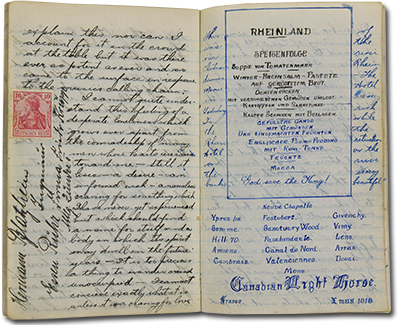
Unfortunately, according to Hambley, there were some problems with the service:
“We were able to seat the whole regiment of 550 men in the one large dining room. And we began a royal feast. –
Twas too bad that one fault spoiled the whole thing for some men because there were not enough waiters and they never thought of having some of our boys do it – This made the courses very short and the waits between very long – and some of the men at the far ends of the room got nothing.”
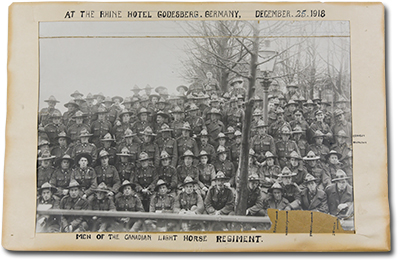
The menu, as drawn, listed the names of the battles in which the Canadian Light Horse fought. The menu and the large photo of many of the men at the dinner (Hambley is in the bottom right corner, three from the right) document the last Christmas that George Hambley and the Canadian Light Horse spent in Europe. The men arrived back in Canada in May 1919.
Search Tip: Search “George Hambley” in Keystone for more information.
Feedback
E-mail us at archiveswebmaster@gov.mb.ca with a comment about this blog post. Your comments may be included on this page.
17 December 2018
“Such an employment would be not only unseemly, but abhorrent”: Controversy and the Winnipeg Cenotaph
The Winnipeg War Memorial Committee was established to oversee the City of Winnipeg’s Cenotaph dedicated to those who died in the First World War. Created in 1924, the Committee’s mandate was to hold a design competition, select a building site for the monument, secure building funds, and to oversee the erection of the cenotaph.
It completed its first competition in 1926 and selected Toronto based sculptor Emmanuel Hahn as the winner. While Hahn had been in Canada since 1892 and was a naturalized Canadian citizen, he was born in Germany. This sparked outrage among many citizens in Winnipeg as they believed Hahn’s German heritage made him a disrespectful choice for veterans and families of fallen soldiers.
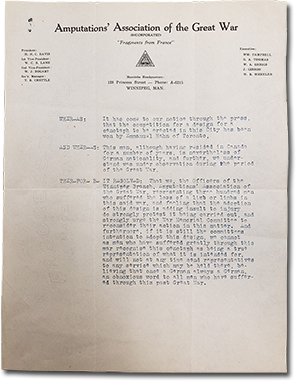
The Amputations’ Association of the Great War sent a resolution to the Committee on February 4th, 1926, stating the following:
“Therefore be it resolved that we, the officers of the Winnipeg Branch, Amputations’ Association of the Great War, representing three hundred men who suffered the loss of a limb or limbs in this said war, and feeling that the adoption of this design is adding insult to injury, do strongly protest it being carried out, and strongly urge the War Memorial Committee to reconsider their action in this matter.”
While some citizens believed the Committee should still employ Hahn since he was a naturalized Canadian citizen, others did not agree with this sentiment. In a letter dated May 19, 1926, from judge Galt of the Manitoba Court of King’s Bench, he believed that:
“The argument in favour of Mr. Hahn is put on the ground that, although he is a German by parentage, he has become a naturalized Canadian or British citizen. Now it seems to me that this question of citizenship is beside the mark. A man whose son had been killed by a member of a Canadian family, while all the other members except one, who was away at the time, approved of the deed, would surely never employ the innocent member of such a family to design and erect a monument to his son’s memory. To my mind, such an employment would be not only unseemly, but abhorrent.”
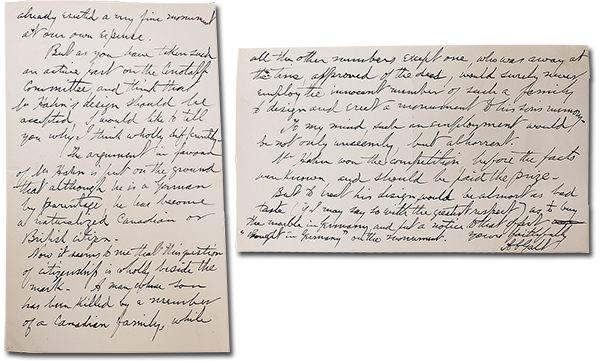
(2 images)
After severe public backlash, the Committee awarded Hahn his $500.00 prize money, but refused to use his design.
The Committee then started a second competition to find a designer. The winner of this competition was Elizabeth Wood, who was born in Orilla, Ontario but resided in Toronto. Even though she won the competition, she was also Hahn’s wife. This caused even more controversy and in November 1927, the citizens of Winnipeg rejected her designs as well.
The Committee awarded Wood her $500.00 prize money and chose the runner-up of the competition, British born sculptor Gilbert Parfitt, to design the cenotaph. He was acceptable to the citizenry and the cenotaph was unveiled to the public on November 7, 1928. The cenotaph still stands in Memorial Park, on York Avenue.
Search Tip: Search Keystone to find out more about the records of the Winnipeg War Memorial Committee.
Feedback
E-mail us at archiveswebmaster@gov.mb.ca with a comment about this blog post. Your comments may be included on this page.
10 December 2018
HBC and the re-instatement of discharged service men into the workforce
The end of the war meant that enlisted men returned to Canada’s cities and towns ready to re-enter the workforce. The issue that many faced was that their previously held positions had been filled or job expectations had changed. Five hundred and twenty-five Hudson’s Bay Company (HBC) employees enlisted for overseas service; 81 of these lost their lives. Before the war even ended, HBC faced the issue of reinstating returned soldiers into its workforce. After a former Calgary store employee was denied his position after his return in July 1918, HBC’s Governor and Committee was compelled to consider the future and what to do with the return of its enlisted employees once the war was over.
On 22 October, 1918, Governor Robert Kindersley wrote to Sir Augustus Nanton, chairman of HBC’s Canadian Committee in Winnipeg:
 (3 images)
(3 images)
“…it is a matter of vital importance that there should be no delay in placing returned soldiers, whose previous record with the Company is satisfactory, on the pay roll of the Company, even if for the moment no suitable employment can be found for them. The difficulty which is going to face all nations on demobilization is the fact that the majority of discharged or demobilized soldiers do not possess the means to enable them to sustain themselves and their families even for a few weeks without employment, and promptitude of re-employment is therefore the essence of the problem.”
Kindersley also addresses potential public relations issues:
“I need not dwell on the injury that bad treatment of old employees returning from the War may have on the Company’s reputation, and indirectly therefore on the popularity of its Stores.”
On 30 November 1918, only a few weeks after the Armistice was signed, Kindersley drafted a letter that was sent to all demobilized HBC employees. In it, he outlines the terms by which the employees will be rehired. He writes:
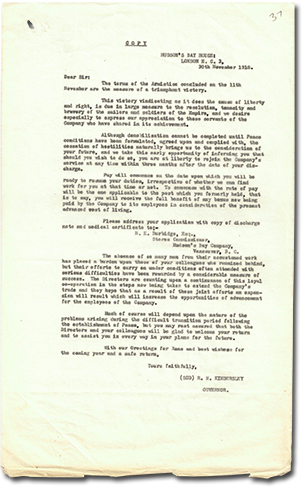
“Although demobilisation cannot be completed until Peace conditions have been formulated, agreed upon and complied with, the cessation of hostilities naturally brings us to the consideration of your future, and we take this early opportunity of informing you that should you wish to do so, you are at liberty to rejoin the Company’s service at any time within three months after the date of your discharge.”
Kindersley goes on to say that employees’ pay would commence on the day they were ready to resume work, even if suitable work was not available for them at that time. Moreover, they would receive the same rate of pay that was given for the job they left before enlisting, which also factored in the increased cost of living.
Kindersley concludes:
“Much of course will depend upon the nature of the problems arising during the difficult transition period following the establishment of Peace, but you may rest assured that both the Directors and your colleagues will be glad to welcome your return and to assist you in every way in your plans for the future.
With our Greetings for Xmas and best wishes for the coming year and a safe return,
Yours faithfully,
(sgd) R. M. Kindersley
Governor.”
Search Tip: Search “Sir Augustus Nanton’s correspondence” in Keystone for more correspondence between the HBC’s London and Winnipeg offices during the war years.
Feedback
E-mail us at archiveswebmaster@gov.mb.ca with a comment about this blog post. Your comments may be included on this page.
3 December 2018
The Spanish Influenza, a visit from the U. S. President and a party with the Queen: Col. R. M. Dennistoun’s report from London

Colonel R. M. Dennistoun remained in London after the Armistice to complete his work as Deputy Judge Advocate General at Canadian HQ. He continued to keep a diary of daily news and his own work and social activities.
On 18 December 1918, he wrote about the “Flu”:
“6 million people have died during the last 12 weeks of influenza and pneumonia throughout the world.
20 million have perished in the 4½ years by reason of the war.
This plague has been much more deadly than the war.
Never since the Black Death has such a plague swept over the world (Times).”
On 23 December 1918, Dennistoun wrote about U. S. President Wilson’s visit to France and England. He records that Wilson had a great reception in France and that he and his wife would be arriving in London on Thursday 26 December as guests of the King:
“He is looked on with a good deal of suspicion as his attitude in regard to the freedom of the seas may not be concurred in by us.
He has spoiled everybody’s holidays by selecting Boxing Day as the date of his arrival.”
Nevertheless, Dennistoun and his family – his wife Mildred and two young daughters (who had lived in England for the duration of the war) and youngest son Peel who served with the Royal Air Force – had a “very good Xmas”. In the afternoon of 25 December, there was a “great party” for overseas Officers at the Royal Albert Hall.
“The Queen was present and gave us a souvenir medal and her Xmas card. The place was full probably 8000 present.
In the evening we danced and sang at the hotel and the children were in great form.
The awful weight of apprehension that hung over us so long is gradually lifting and we can enjoy things with a really light heart.”
R. M. Dennistoun returned to Manitoba in March 1919, and was sworn in as a Court of Appeal judge but then went back to London to complete his work at headquarters. He finally returned to Winnipeg in September 1919 and was demobilized in October 1919. He was a Court of Appeal judge until his retirement in 1946.
Search Tip: Search “Dennistoun” in Keystone for more information.
Feedback
E-mail us at archiveswebmaster@gov.mb.ca with a comment about this blog post. Your comments may be included on this page.




